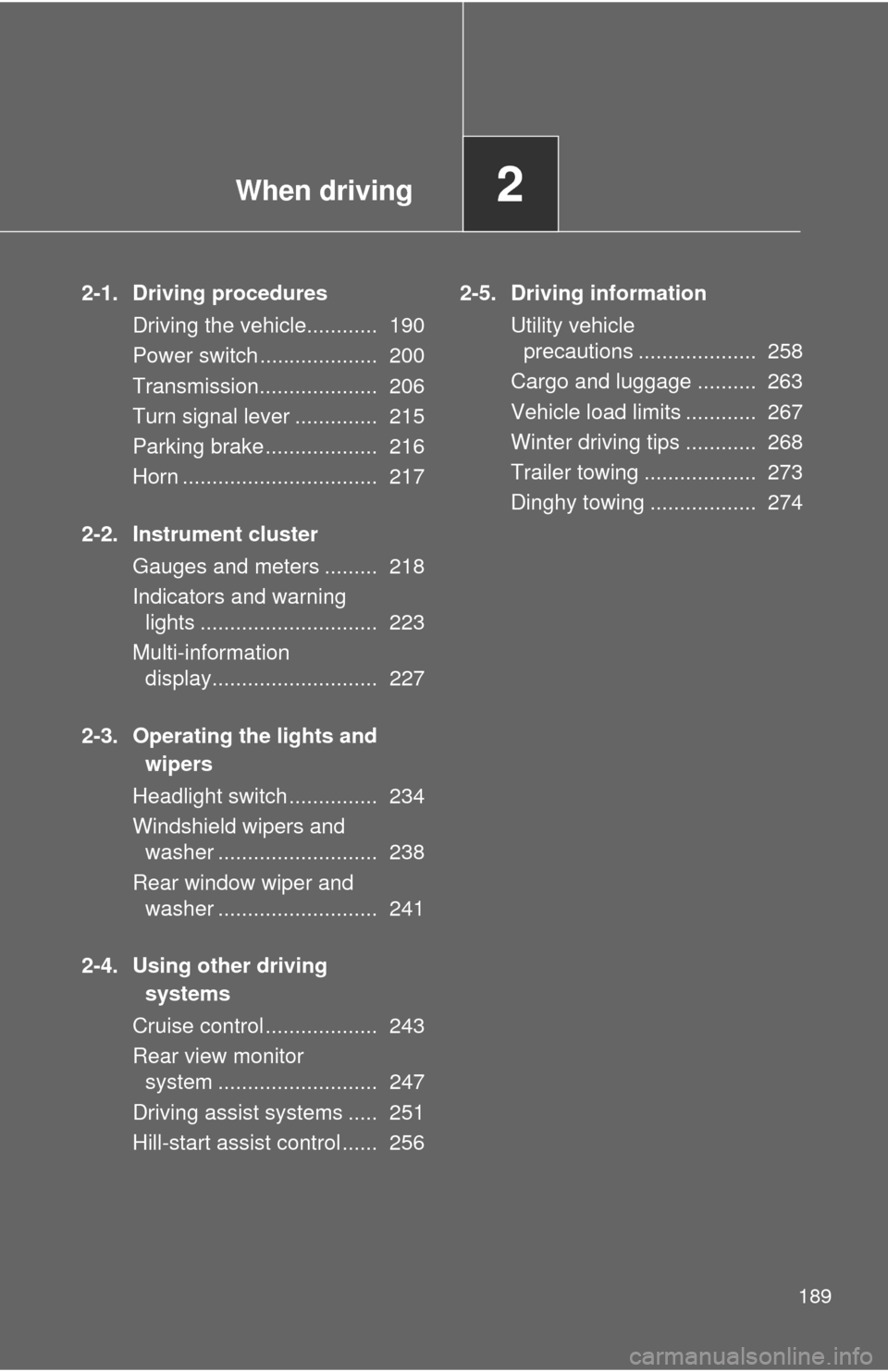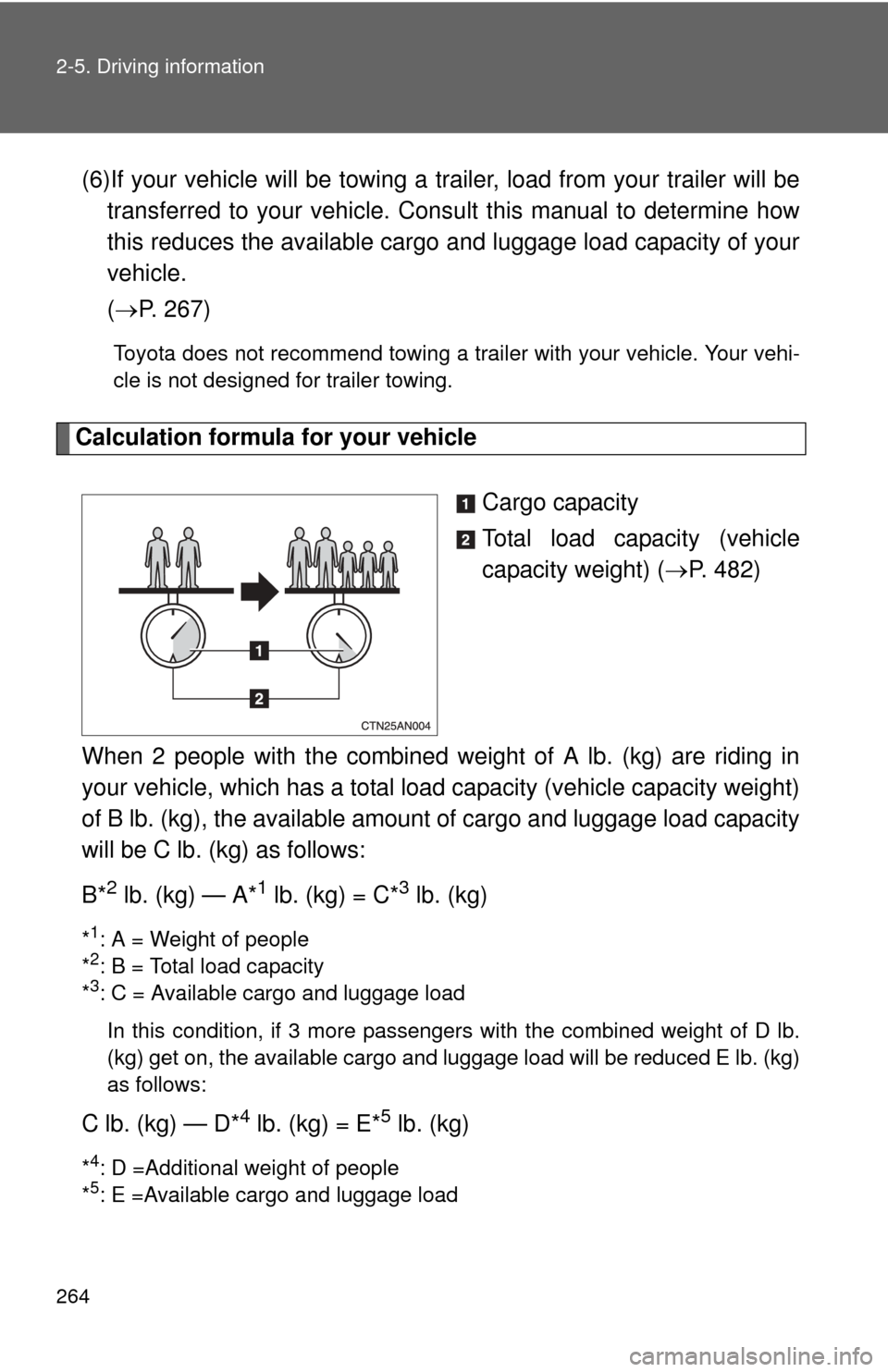Page 3 of 520

1
2
3
4
5
6
7
3
2-1. Driving proceduresDriving the vehicle............... 190
Power switch ....................... 200
Transmission....................... 206
Turn signal lever ................. 215
Parking brake ...................... 216
Horn .................................... 217
2-2. Instrument cluster Gauges and meters ............ 218
Indicators and warning lights ................................. 223
Multi-information display ..... 227
2-3. Operating the lights and wipers
Headlight switch .................. 234
Windshield wipers and washer .............................. 238
Rear window wiper and washer .............................. 241
2-4. Using other driving systems
Cruise control ...................... 243
Rear view monitor system .............................. 247
Driving assist systems ........ 251
Hill-start assist control ......... 256 2-5. Driving information
Utility vehicle precautions....................... 258
Cargo and luggage ............. 263
Vehicle load limits............... 267
Winter driving tips ............... 268
Trailer towing ...................... 273
Dinghy towing ..................... 274
3-1. Using the air conditioning system and defogger
Automatic air conditioning system.......... 276
Rear window and outside rear view mirror
defoggers ......................... 292
3-2. Using the interior lights Interior lights list ................. 293
• Personal/interior light main switch ...................... 294
• Personal/interior lights...... 294
• Interior light ...................... 295
• Luggage compartment light................................... 295
3-3. Using the storage features List of storage features ....... 296
• Glove box ......................... 297
• Console box ..................... 298
• Cup holders ...................... 299
• Bottle holders ................... 300
• Auxiliary boxes ................. 302
2When driving
3Interior features
Page 36 of 520

36 1-1. EV system
CAUTION
■Road accident cautions
Observe the following precautions to reduce the risk of death or serious
injury:
●Stop the vehicle in a safe place, apply the parking brake while depressing
the brake pedal, shift the shift position to P and turn the EV system off.
Then gradually release the brake pedal.
● Do not touch the high voltage parts, cables or connectors.
● If electric wires are exposed inside or outside your vehicle, an electric
shock may occur. Never touch exposed electric wires.
● Do not touch the traction battery if liquid is leaking from or adhering to it.
If electrolyte (Organic Carbonate-based electrolyte) from the traction bat-
tery comes into contact with the eyes or skin, it could cause blindness or
skin wounds. In the unlikely event that it comes into contact with the eyes
or skin, wash it off immediately with a large amount of water, and seek
immediate medical attention.
● If electrolyte is leaking from the traction battery, do not approach the vehi-
cle.
Even in the unlikely event that the traction battery is damaged, the internal
construction of the battery will prevent a large amount of electrolyte from
leaking out. However, any electrolyte that does leak out will give off acidic
fumes. These fumes are an irritant to skin and eyes and could cause acute
poisoning if inhaled.
● Do not bring burning or high-temperat ure items close to the electrolyte.
The electrolyte may ignite and cause a fire.
● If a fire occurs in the electric vehicle, leave the vehicle as soon as possi-
ble. Never use a fire extinguisher that is not meant for electrical fires.
Using even a small amount of water may be dangerous.
● If your vehicle needs to be towed, do so with the front wheels raised. If the
wheels connected to the electric motor (traction motor) are on the ground
when towing, the motor may continue to generate electricity. This may
cause an electricity leakage leading to a fire. ( P. 413)
Page 126 of 520
126 1-6. Adjustable components (seats, mirrors, steering wheel)
NOTICE
■Stowing the seat belts
The seat belts and the buckles must be stowed before you fold down the
rear seatbacks.
Page 133 of 520
133
1-6. Adjustable components (s
eats, mirrors, steering wheel)
1
Before driving
■Releasing method
The rear center seat belt can be completely released only when
necessary such as when folding down the rear seats.
To release tab “A”, insert tab “B”
or the mechanical key (P. 94)
into the hole on the buckle.
Retract the belt slowly when
releasing and stowing the seat
belt.
Fold the seat belt.
Fold the seat belt in a manner
that places tabs “A” and “B” on
top of each other, as shown in the
illustration.
Stow the seat belt.
Make sure that the tabs are
securely stowed inside the cover.
STEP 1
STEP 2
STEP 3
Page 189 of 520

When driving2
189
2-1. Driving proceduresDriving the vehicle............ 190
Power switch .................... 200
Transmission.................... 206
Turn signal lever .............. 215
Parking brake ................... 216
Horn ................................. 217
2-2. Instrument cluster Gauges and meters ......... 218
Indicators and warning lights .............................. 223
Multi-information display............................ 227
2-3. Operating the lights and wipers
Headlight switch ............... 234
Windshield wipers and washer ........................... 238
Rear window wiper and washer ........................... 241
2-4. Using other driving systems
Cruise control ................... 243
Rear view monitor system ........................... 247
Driving assist systems ..... 251
Hill-start assist control ...... 256 2-5. Driving information
Utility vehicle precautions .................... 258
Cargo and luggage .......... 263
Vehicle load limits ............ 267
Winter driving tips ............ 268
Trailer towing ................... 273
Dinghy towing .................. 274
Page 264 of 520

264 2-5. Driving information
(6)If your vehicle will be towing a trailer, load from your trailer will be
transferred to your vehicle. Cons ult this manual to determine how
this reduces the available cargo and luggage load capacity of your
vehicle.
( P. 267)
Toyota does not recommend towing a traile r with your vehicle. Your vehi-
cle is not designed for trailer towing.
Calculation formula for your vehicle
Cargo capacity
Total load capacity (vehicle
capacity weight) (P. 482)
When 2 people with the combined weight of A lb. (kg) are riding in
your vehicle, which has a total load capacity (vehicle capacity weight)
of B lb. (kg), the available amount of cargo and luggage load capacity
will be C lb. (kg) as follows:
B*
2 lb. (kg) — A*1 lb. (kg) = C*3 lb. (kg)
*1: A = Weight of people
*2: B = Total load capacity
*3: C = Available cargo and luggage load
In this condition, if 3 more passengers with the combined weight of D lb.
(kg) get on, the available cargo and luggage load will be reduced E lb\
. (kg)
as follows:
C lb. (kg) — D*4 lb. (kg) = E*5 lb. (kg)
*4: D =Additional weight of people
*5: E =Available cargo and luggage load
Page 267 of 520
267
2-5. Driving information
2
When driving
Vehicle load limits
■Total load capacity and seating capacity
These details are also described on the tire and loading information
label. (P. 374)
CAUTION
■Overloading the vehicle
Do not overload the vehicle.
It may not only cause damage to the ti res, but also degrade steering and
braking ability, resulting in an accident.
Vehicle load limits include total load capacity, seating capacity,
towing capacity and cargo capacity.
■ Total load capacity (vehicle capacity weight): ( P. 482)
Total load capacity means the combined weight of occupants, cargo
and luggage.
■ Seating capacity: 5 occupants (Front 2, Rear 3)
Seating capacity means the maxi mum number of occupants whose
estimated average weight is 150 lb. (68 kg) per person.
■ Towing capacity
Toyota does not recommend towing a trailer with your vehicle.
■Cargo capacity
Cargo capacity may increase or decrease depending on the weight
and the number of occupants.
Page 273 of 520
273
2-5. Driving information
2
When driving
Trailer towing
Toyota does not recommend towing a trailer with your vehicle.
Toyota also does not recommend the installation of a tow hitch or
the use of a tow hitch carrier for a wheelchair, scooter, bicycle, etc.
Your vehicle is not designed for tra iler towing or for the use of tow
hitch mounted carriers.